“The reason I love it here is because we care for native wildlife. If you go hiking in the Northwest, you’ll never see a lion or zebra, but you might see elk or black bear. Teaching people how to live conflict-free with wildlife – that’s what’s so cool about this job.” – Haley, carnivore keeper, Northwest Trek
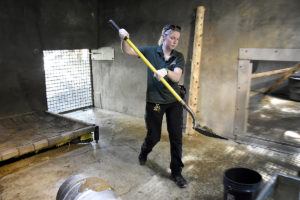
10:30am
Haley’s hot and sweaty. She’s been whacking weeds in the wolf habitat for two and a half hours, and now it’s time to clean out grizzly bear dens.
“We wear many hats,” she says with a small smile, of herself, fellow keeper Jordan and animal keeper assistant Carly.
Heading for the prep kitchen shared with the Wetlands keepers, she grabs a water bottle and sandwich (from the people-food fridge, not the animal-food fridge) and gets straight back to work.
Like most keepers, Haley starts work at 7:30am by checking email, then feeding her charges: gray wolves, foxes, black and grizzly bears, bobcat, cougar and lynx. At the same time she’s checking them visually for good health and normal behavior, making notes for the veterinarian and keeper team.
Next comes maintenance – and in summer that means a lot of yard work in the forested exhibit areas.
And then it’s grizzly time.
When they were younger, Hawthorne and Huckleberry were still spending nights indoors to keep them safe, which meant a lot more cleaning work than for the adult black bears. Behind the scenes, Haley double checks the locks keeping the cubs out of their dens, then swings open the doors and grabs a tall shovel and pail. She does the rounds of both dens, scooping up piles of bear poop with swift, expert moves.
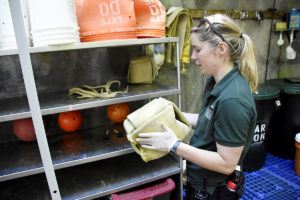
“Poop is so important, it’s a major part of what we do,” Haley explains. “You learn so much about an animal’s health from their input and output. I’m looking for signs of parasites, inflammation, possible illness or just what they’ve eaten.”
She smiles wryly. “My phone is full of pictures of poop. So when I hear people telling their kids they need to go to college to avoid doing my job, that’s so ironic. I have a bachelors’ degree, and I want to be the one to scoop the poop because interns or less-experienced keepers might not know what to look for.”
After scooping, Haley hauls out dirty enrichment items – bear toys like giant PVC pipe puzzle feeders and balls – and starts hosing everything down. Despite her petite frame she drags hammock beds and empties massive splash buckets with the ease of a weight-lifter. Winter brings extra challenges to this chore: “I have to squeegee a lot, or it turns into a big ice patch. And with rain, snow, hail or wind, we have to figure out ways to make the animals more comfortable.”
Which is another reason Haley likes working with native species: they are adapted to the environment and don’t need as much human intervention for comfort.
11:15am
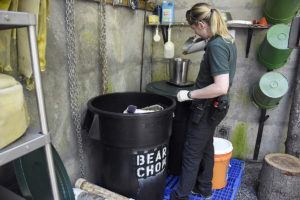
With both dens clean and mopped, Haley hoses off the enrichment items and heads for a giant barrel in the corner marked “Bear Chow”. It’s the grizzlies’ second feed for the day – they get four, their diet changing according to the season – and for this one she’ll spread food around their tree-filled habitat to encourage natural foraging behaviors.
First, she triple-locks the human doors into the dens. Hawthorne is already nosing from the other side, eager to see what’s coming. Haley radios staff to alert them of a bear shift, then raises the tall outside gates. Hawthorne’s first up at the mesh, and Haley gently feeds him some treats, making sure to keep her fingers on her own side of the mesh. The bear licks up the treats delightedly, and then it’s Huckleberry’s turn.
“That’s it, boy,” Haley says, calmly, lowering the outside gates. More lock-checks, then she’s out in the habitat herself, hiding bear chow, fruit and veggies under logs and inside stumps. At the same time, she’s checking the fence line and every inch of the space to make sure everything’s safe and in order.
“Hi there!” she calls to curious watching visitors. “Just give me five minutes and the cubs will be out and feeding.”
11:30am
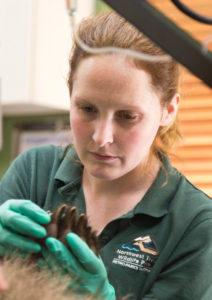
Back inside, with both cubs happily foraging, Haley cleans and packs away all the equipment before heading around to do the same for the big cats, helped by Carly and two part-time keepers. Other mornings might include veterinary procedures, which give keepers an important opportunity to examine their charges close-up and chat to the veterinarian about care.
12:30pm
After feeding, cleaning and lunch, it’s project time.
“We give new enrichment items every day, and bears are pretty good at destroying things, so we try to have plenty ready to go,” says Haley, who makes many of the items herself from PVC pipes, old bowling balls, large barrels or fire hoses woven into sausages. Most of the items can hide food to challenge the bears mentally and physically.
Haley has also had to become a power tool expert, building things like a support for Carly the cougar to rest her tail on while training for blood draws.
“Everything I know how to do, I learned it here,” says Haley, who began at Northwest Trek as an intern in 2013 during her final year of college, and became a keeper nine months later.
1:30pm
It’s time for the Keeper Chat, and Haley heads over to the cougar habitat to help Carly.
2pm
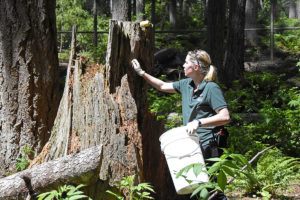
Training also happens in the afternoon. Haley and her team work with every animal to reward behaviors that help with their care: holding still, raising a paw, opening their mouth and so on.
“The black bears know a lot of behaviors – they’ll let us take blood, and listen to their hearts with a stethoscope,” says Haley. “The cubs are learning more, too.”
Carly the cougar takes extra patience, calmness and respect, something Haley has in spades for this beautiful, wary animal.
“When you start working with an animal you’re not its best friend right away,” she explains. “With Carly it’s taken years to build this relationship. Respect is so important – just sitting, talking to them, offering their favorite treat, not being scary or unpredictable. And behaving the way they like you to: with bears and wolves that’s being excited; with the cats, it’s calm. It’s not like you’re Snow White. You have to keep working at it, every day.”
3:30pm
The cubs get their final feed, and Haley’s day is over.
“The days go by really fast,” she says. “I don’t get to sit down a lot. But I’d still choose this job over a desk job. For me this is such fulfilling work, even when it starts all over every 24 hours. I never dreamed I’d be a zookeeper – I did environmental science and I always thought I’d be working for the Department of Ecology or Fish and Wildlife. But this is so rewarding. Working with native animals, helping people understand wildlife – it’s the best.”